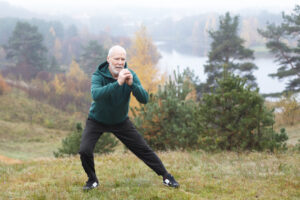What Is Parkinson’s Disease?
Parkinson’s Disease (PD) is a neurodegenerative disorder that affects the central nervous system, primarily impacting motor functions. It is a chronic and progressive condition, meaning it worsens over time. The disease occurs when certain nerve cells in the brain that produce dopamine gradually degenerate.
Since PD affects motor functions, individuals living with it will gradually begin to experience movement issues, including a loss of balance, loss of muscle strength and endurance, and decreased flexibility and range of motion. The muscles affecting speech and facial expressions will also be affected, reducing an individual’s ability to communicate loudly, clearly, and effectively.
What Treatments Are Available For Parkinson’s Disease?
Although there is currently no cure for Parkinson’s, there are treatments – including medications and physical therapy – that can help patients manage their symptoms, maintain some of their independence, and potentially slow down the progression of the disease.
In fact, it’s been scientifically proven that physical therapy plays an important role in maintaining a high quality of life for people with PD. Since PD targets motor function, physical therapy helps patients retain their muscle strength and flexibility while providing them with fall-prevention strategies to reduce their risk of injury as their disease progresses.
Additionally, a specialized method of treatment – called LSVT BIG – helps patients counteract the slowness and rigidity that occurs as the disease progresses, allowing them to move more “normally.”

LSVT BIG
The LSVT BIG treatment method is a scientifically backed approach that allows physical therapists to become certified in specialized techniques to treat patients with PD and other neurological disorders. LSVT BIG is considered the “gold standard” treatment method for PD.
As PD progresses, the movements of people living with it get smaller, slower, and less impactful. LSVT BIG teaches patients to recalibrate their movements so that they can amplify and enhance their actions. It also helps them learn how to put more effort and force into their movements to be “more like the movements of everyone around them.”
LSVT BIG treatment plans are uniquely customized to each patient’s needs and goals. Since it’s not a “one-size-fits-all” approach, it’s possible to start treatment at any stage of disease progression – although – as with most things – the earlier patients begin LSVT BIG treatment, the better their outcomes will be.

LSVT LOUD
LSVT BIG has a sister program called LSVT LOUD that certifies speech therapists to help individuals with PD maintain their ability to speak and communicate effectively.
People with Parkinson’s often experience speech and voice difficulties due to the impact of the disease on the muscles involved in speech production. LSVT LOUD is a speech therapy program that focuses on intensive exercises to strengthen these muscles and improve speech function – including vocal loudness and clarity – making it easier for them to communicate effectively.
LSVT BIG Treatment At Dosher Physical Therapy
At Dosher Physical Therapy, we’re thrilled to be welcoming Casey Bishe, DPT to our team! Casey, who
received her bachelor’s degree in Psychology from Marquette University in 2017 and then went on to complete her doctor of physical therapy at Franklin Pierce in 2020, enjoys working with patients across all ages and abilities. She’s particularly passionate about working with our older patients and those who live with vertigo.
In addition, Casey will be joining Heather Conner, PTA, on our roster of LSVT BIG certified practitioners here at Dosher Physical Therapy.
If you’re interested in learning more about how physical therapy and LSVT BIG can help patients with Parkinson’s Disease maintain their movement and independence, give us a call. We’re happy to work with you and your care team to create a treatment plan that’s suited to your unique needs.






